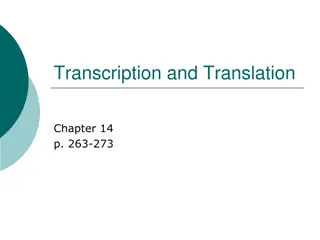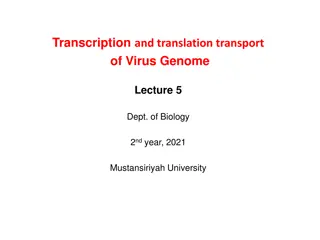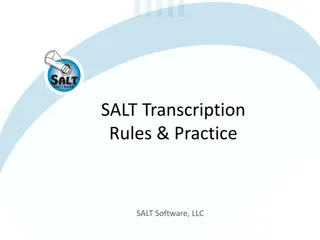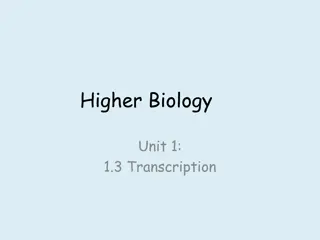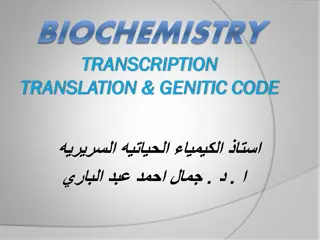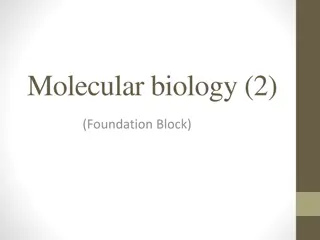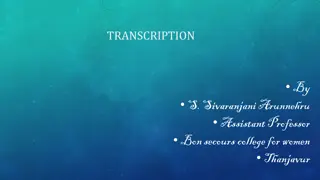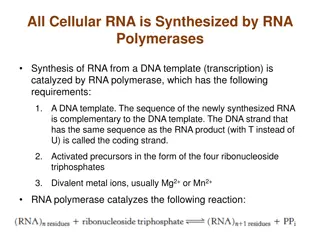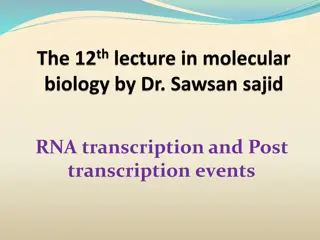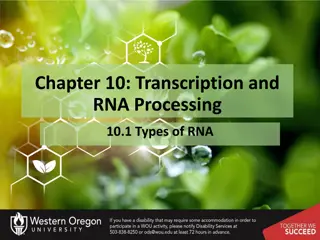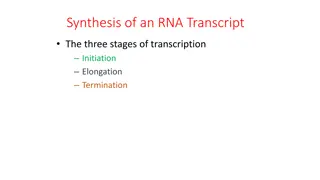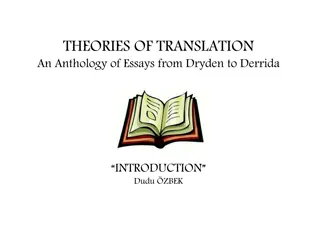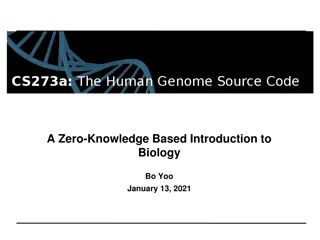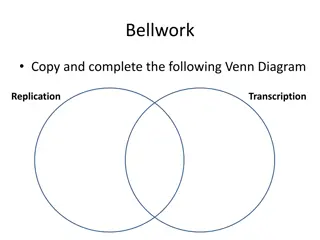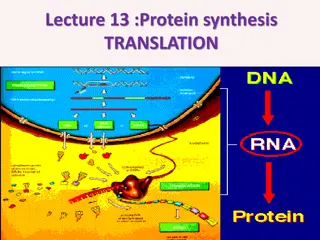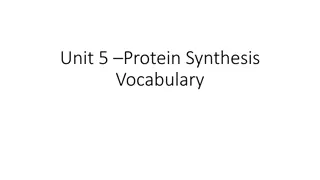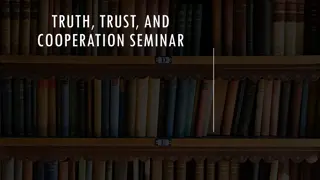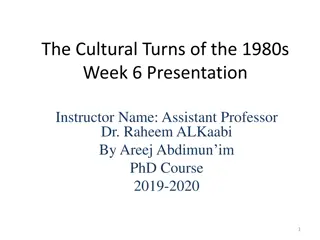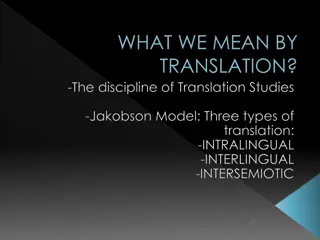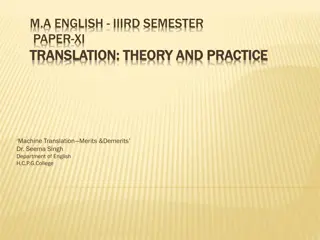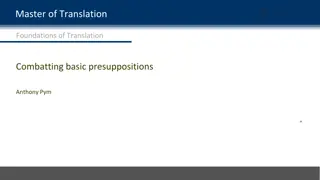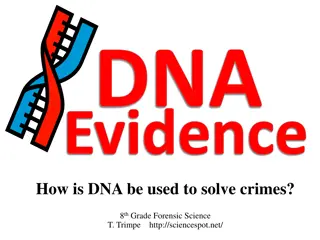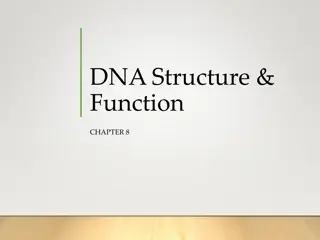Understanding DNA Transcription and Translation in Biology
DNA transcription is the process where DNA is used as a template to create mRNA in the nucleus. This mRNA is complementary to the DNA and goes through initiation, elongation, and termination stages. RNA polymerases are essential for this process in eukaryotes. Various RNA polymerases have specific functions, such as RNA polymerase I and III for ribosomal and structural RNAs, and RNA polymerase II for protein-coding pre-mRNAs. This transcription process is crucial for gene expression and protein synthesis.
Download Presentation

Please find below an Image/Link to download the presentation.
The content on the website is provided AS IS for your information and personal use only. It may not be sold, licensed, or shared on other websites without obtaining consent from the author. Download presentation by click this link. If you encounter any issues during the download, it is possible that the publisher has removed the file from their server.
E N D
Presentation Transcript
DNA Transcription and Translation Biology for Majors
Transcription Transcription takes place in the nucleus. It uses DNA as a template to make an RNA (mRNA) molecule. During transcription, a strand of mRNA is made that is complementary to a strand of DNA.
Steps of Transcription
Initiation Initiation occurs when the enzyme RNA polymerase binds to a region of a gene called the promoter. This signals the DNA to unwind so the enzyme can read the bases in one of the DNA strands.
Elongation Elongation is the addition of nucleotides to the mRNA strand. RNA polymerase reads the unwound DNA strand and builds the mRNA molecule, using complementary base pairs. There is a brief time during this process when the newly formed RNA is bound to the unwound DNA. During this process, an adenine (A) in the DNA binds to an uracil (U) in the RNA.
Termination Termination is the ending of transcription, and occurs when RNA polymerase crosses a stop (termination) sequence in the gene. The mRNA strand is complete, and it detaches from DNA.
RNA Polymerases Unlike the prokaryotic polymerase that can bind to a DNA template on its own, eukaryotes require several other proteins, called transcription factors, to first bind to the promoter region and then help recruit the appropriate polymerase.
RNA Polymerase I and III RNA polymerase I is located in the nucleolus, a specialized nuclear substructure in which ribosomal RNA (rRNA) is transcribed, processed, and assembled into ribosomes. The rRNA molecules are considered structural RNAs because they have a cellular role but are not translated into protein. RNA polymerase III is also located in the nucleus. This polymerase transcribes a variety of structural RNAs that includes the 5S pre-rRNA, transfer pre-RNAs (pre-tRNAs), and small nuclear pre-RNAs.
RNA polymerase II RNA polymerase II is located in the nucleus and synthesizes all protein-coding nuclear pre-mRNAs. Eukaryotic pre-mRNAs undergo extensive processing after transcription but before translation: introns must be spliced out and a 5 cap and 3 poly-A tail are added.
Structure of an RNA polymerase II promoter Transcription factors recognize the promoter. RNA polymerase II then binds and forms the transcription initiation complex.
Transcription Factors for RNA Polymerase II An army of basal transcription factors, enhancers, and silencers also help to regulate the frequency with which pre-mRNA is synthesized from a gene. Enhancers and silencers affect the efficiency of transcription but are not necessary for transcription to proceed. Basal transcription factors are crucial in the formation of a preinitiation complex on the DNA template that subsequently recruits RNA polymerase II for transcription initiation.
Promoters for RNA Polymerase I and III RNA polymerase I transcribes genes that have two GC-rich promoter sequences in the 45 to +20 region. These sequences alone are sufficient for transcription initiation to occur, but promoters with additional sequences in the region from 180 to 105 upstream of the initiation site will further enhance initiation. Genes that are transcribed by RNA polymerase III have upstream promoters or promoters that occur within the genes themselves.
Elongation by RNA Polymerase II For polynucleotide synthesis to occur, the transcription machinery needs to move histones out of the way every time it encounters a nucleosome. This is accomplished by a special protein complex called FACT, which stands for facilitates chromatin transcription. This complex pulls histones away from the DNA template as the polymerase moves along it. Once the pre-mRNA is synthesized, the FACT complex replaces the histones to recreate the nucleosomes.
Termination differs by polymerase The termination of transcription is different for the different polymerases. Unlike in prokaryotes, elongation by RNA polymerase II in eukaryotes takes place 1,000 2,000 nucleotides beyond the end of the gene being transcribed. This pre-mRNA tail is subsequently removed by cleavage during mRNA processing. On the other hand, RNA polymerases I and III require termination signals. Genes transcribed by RNA polymerase I contain a specific 18-nucleotide sequence that is recognized by a termination protein. The process of termination in RNA polymerase III involves an mRNA hairpin similar to rho-independent termination of transcription in prokaryotes.
Locations, Products, and Sensitivities of the Three Eukaryotic RNA Polymerases RNA Polymerase Cellular Compartment Product of Transcription All rRNAs except 5S rRNA All protein- coding nuclear pre- mRNAs 5S rRNA, tRNAs, and small nuclear RNAs -Amanitin Sensitivity I Nucleolus Insensitive Extremely sensitive II Nucleus Moderately sensitive III Nucleus
pre-RNA and mRNA After transcription, eukaryotic pre-mRNAs must undergo several processing steps before they can be translated. Eukaryotic (and prokaryotic) tRNAs and rRNAs also undergo processing before they can function as components in the protein synthesis machinery. The eukaryotic pre-mRNA undergoes extensive processing before it is ready to be translated. The additional steps involved in eukaryotic mRNA maturation create a molecule with a much longer half-life than a prokaryotic mRNA.
mRNA Processing 5 Capping While the pre-mRNA is still being synthesized, a 7-methylguanosine cap is added to the 5 end of the growing transcript by a phosphate linkage. This moiety (functional group) protects the nascent mRNA from degradation. 3 Poly-A Tail Once elongation is complete, the pre-mRNA is cleaved by an endonuclease between an AAUAAA consensus sequence and a GU-rich sequence, leaving the AAUAAA sequence on the pre-mRNA. An enzyme called poly-A polymerase then adds a string of approximately 200 A residues, called the poly-A tail. This modification further protects the pre-mRNA from degradation and signals the export of the cellular factors that the transcript needs to the cytoplasm.
Pre-mRNA Splicing Pre-mRNA splicing involves the precise removal of introns from the primary RNA transcript. The splicing process is catalyzed by protein complexes called spliceosomes that are composed of proteins and RNA molecules called snRNAs. Spliceosomes recognize sequences at the 5 and 3 end of the intron.
RNA Post-Translational Modification Gene expression can be regulated at various stages after an RNA transcript has been produced. Some transcripts can undergo alternative splicing. This regulated process makes different mRNAs and proteins from the same initial RNA transcript. Some mRNAs are targeted by small regulatory RNAs, including miRNAs, which can cause mRNA degradation or block translation. A protein s activity may be regulated after translation by mechanisms such as proteolysis ( snipping out of pieces) and addition of chemical groups.
Alternative Splicing In the process of alternative splicing, different portions of an mRNA can be selected for use as exons. This allows either of two (or more) mRNA molecules to be made from one pre-mRNA. The process is controlled by regulatory proteins.
microRNA help control mRNA lifespan and translation
Making Proteins Translation, or protein synthesis is the decoding of an mRNA message into a polypeptide product. A peptide bond links the carboxyl end of one amino acid with the amino end of another, expelling one water molecule.
Translation Translation begins when an initiator tRNA anticodon recognizes a codon on mRNA. The large ribosomal subunit joins the small subunit, and a second tRNA is recruited. As the mRNA moves relative to the ribosome, the polypeptide chain is formed. Entry of a release factor into the A site terminates translation and the components dissociate.
Initiation in Eukaryotes Protein synthesis begins with the formation of an initiation complex (mRNA, the 40S small ribosomal subunit, IFs, and nucleoside triphosphates GTP and ATP). Once the appropriate AUG is identified using Kozak s rules, the other proteins and CBP dissociate, and the 60S subunit binds to the complex of Met-tRNAi, mRNA, and the 40S subunit.
Ribosomes A ribosome is a complex macromolecule composed of structural and catalytic rRNAs, and many distinct polypeptides. In eukaryotes, the nucleolus is completely specialized for the synthesis and assembly of rRNAs. Ribosomes exist in the cytoplasm in prokaryotes and in the cytoplasm and rough endoplasmic reticulum in eukaryotes. Mitochondria and chloroplasts also have their own ribosomes in the matrix and stroma, which look more similar to prokaryotic ribosomes (and have similar drug sensitivities) than the ribosomes just outside their outer membranes in the cytoplasm.
Subunits and the Polysome Ribosomes dissociate into large and small subunits when they are not synthesizing proteins and reassociate during the initiation of translation. The small subunit is responsible for binding the mRNA template, whereas the large subunit sequentially binds tRNAs. Each mRNA molecule is simultaneously translated by many ribosomes, all synthesizing protein in the same direction: reading the mRNA from 5 to 3 and synthesizing the polypeptide from the N terminus to the C terminus. The complete mRNA/poly-ribosome structure is called a polysome.
tRNA Serving as adaptors, specific tRNAs bind to sequences on the mRNA template and add the corresponding amino acid to the polypeptide chain. Therefore, tRNAs are the molecules that actually translate the language of RNA into the language of proteins.
Aminoacyl tRNA Synthetases The process of pre-tRNA synthesis by RNA polymerase III only creates the RNA portion of the adaptor molecule. The corresponding amino acid must be added later, once the tRNA is processed and exported to the cytoplasm. Through the process of tRNA charging, each tRNA molecule is linked to its correct amino acid by a group of enzymes called aminoacyl tRNA synthetases. At least one type of aminoacyl tRNA synthetase exists for each of the 20 amino acids; the exact number of aminoacyl tRNA synthetases varies by species. These enzymes first bind and hydrolyze ATP to catalyze a high-energy bond between an amino acid and adenosine monophosphate (AMP); a pyrophosphate molecule is expelled in this reaction. The activated amino acid is then transferred to the tRNA, and AMP is released.
Processing of tRNA and rRNA The tRNAs and rRNAs are structural molecules that have roles in protein synthesis; however, these RNAs are not themselves translated. Pre-rRNAs are transcribed, processed, and assembled into ribosomes in the nucleolus. Pre-tRNAs are transcribed and processed in the nucleus and then released into the cytoplasm where they are linked to free amino acids for protein synthesis. Most of the tRNAs and rRNAs in eukaryotes and prokaryotes are first transcribed as a long precursor molecule that spans multiple rRNAs or tRNAs. Enzymes then cleave the precursors into subunits corresponding to each structural RNA.
tRNA Structure Mature tRNAs take on a three- dimensional structure through intramolecular hydrogen bonding to position the amino acid binding site at one end and the anticodon at the other end. The anticodon is a three- nucleotide sequence in a tRNA that interacts with an mRNA codon through complementary base pairing.
Codons Amino acids are encoded by nucleotide triplets and that the genetic code was degenerate. In other words, a given amino acid could be encoded by more than one nucleotide triplet. The deletion of two nucleotides shifts the reading frame of an mRNA and changes the entire protein message, creating a nonfunctional protein or terminating protein synthesis altogether.
The Genetic Code This figure shows the genetic code for translating each nucleotide triplet in mRNA into an amino acid or a termination signal in a nascent protein.
Protein Modifications During and after translation, individual amino acids may be chemically modified, signal sequences may be appended, and the new protein folds into a distinct three-dimensional structure as a result of intramolecular interactions. A signal sequence is a short tail of amino acids that directs a protein to a specific cellular compartment. Many proteins fold spontaneously, but some proteins require helper molecules, called chaperones, to prevent them from aggregating during the complicated process of folding. Even if a protein is properly specified by its corresponding mRNA, it could take on a completely dysfunctional shape due to environmental conditions at this stage.
Chemical Modifications and Protein Activity Proteins can be chemically modified with the addition of groups including methyl, phosphate, acetyl, and ubiquitin groups. The addition or removal of these groups from proteins regulates their activity or the length of time they exist in the cell. Chemical modifications occur in response to external stimuli such as stress, the lack of nutrients, heat, or ultraviolet light exposure. These changes can alter epigenetic accessibility, transcription, mRNA stability, or translation all resulting in changes in expression of various genes. This is an efficient way for the cell to rapidly change the levels of specific proteins in response to the environment.
Chemical Modifications and Protein Longevity Proteins with ubiquitin tags are marked for degradation within the proteasome.
Prokaryotic Transcription In prokaryotes, mRNA synthesis is initiated at a promoter sequence on the DNA template comprising two consensus sequences that recruit RNA polymerase. The prokaryotic polymerase consists of a core enzyme of four protein subunits and a protein that assists only with initiation. Elongation synthesizes mRNA in the 5 to 3 direction at a rate of 40 nucleotides per second. Termination liberates the mRNA and occurs either by rho protein interaction or by the formation of an mRNA hairpin.
Prokaryotic Promoters The subunit of prokaryotic RNA polymerase recognizes consensus sequences found in the promoter region upstream of the transcription start sight. The subunit dissociates from the polymerase after transcription has been initiated.
Elongation in Prokayotes During elongation, the prokaryotic RNA polymerase tracks along the DNA template, synthesizes mRNA in the 5 to 3 direction, and unwinds and rewinds the DNA as it is read.
Simultaneous Transcription and Translation Multiple polymerases can transcribe a single bacterial gene while numerous ribosomes concurrently translate the mRNA transcripts into polypeptides. In this way, a specific protein can rapidly reach a high concentration in the bacterial cell.
Translation in Bacteria Versus Eukaryotes Property Bacteria Eukaryotes 70S 30S (small subunit) with 16S rNA subunit 50S (large subunit) with 5S and 23S rRNA subunits 80S 40S (small subunit) with 18S rRNA subunit 60S (large subunit) with 5S, 5.8S, and 28S rRNA subunits Ribosomes Amino acid carried by initiator tRNA fMet Met Shine-Dalgarno sequence in mRNA Present Absent Simultaneous transcription and translation Yes No
Gene Expression in Prokaryotes and Eukaryotes (a) In prokaryotes, transcription and translation occur at the same time in the cytoplasm, allowing for a rapid response to environmental cues. (b) In eukaryotes, transcription is in the nucleus and translation in the cytoplasm, separating these processes and requiring RNA processing for stability.
The Central Dogma of Life Information flow in all organism takes place from DNA to RNA to protein: DNA is transcribed to RNA via complementary base pairing rules (but with U instead of T in the transcript) The RNA transcript, specifically mRNA, is then translated to an amino acid polypeptide Final folding and modifications of the polypeptide lead to functional proteins that actually do things in cells
Practice Question #1 Match the process with the summary: RNA to Protein Transcription DNA to DNA Translation DNA to RNA Replication
Practice Question #2 Genetic engineering often uses bacteria to synthesize proteins for use in humans. How is this possible and why might bacteria be better for this purpose than eukaryotic cells?
Quick Review Outline the process of eukaryotic transcription Summarize the process of translation Outline the process of prokaryotic transcription and translation Identify the central dogma of life


